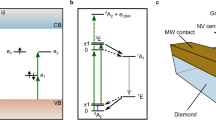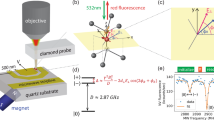Abstract
The ability to sensitively detect individual charges under ambient conditions would benefit a wide range of applications across disciplines. However, most current techniques are limited to low-temperature methods such as single-electron transistors1,2, single-electron electrostatic force microscopy3 and scanning tunnelling microscopy4. Here we introduce a quantum-metrology technique demonstrating precision three-dimensional electric-field measurement using a single nitrogen-vacancy defect centre spin in diamond. An a.c. electric-field sensitivity reaching 202±6 V cm−1 Hz−1/2 has been achieved. This corresponds to the electric field produced by a single elementary charge located at a distance of ∼150 nm from our spin sensor with averaging for one second. The analysis of the electronic structure of the defect centre reveals how an applied magnetic field influences the electric-field-sensing properties. We also demonstrate that diamond-defect-centre spins can be switched between electric- and magnetic-field sensing modes and identify suitable parameter ranges for both detector schemes. By combining magnetic- and electric-field sensitivity, nanoscale detection and ambient operation, our study should open up new frontiers in imaging and sensing applications ranging from materials science to bioimaging.
This is a preview of subscription content, access via your institution
Access options
Subscribe to this journal
Receive 12 print issues and online access
$259.00 per year
only $21.58 per issue
Buy this article
- Purchase on SpringerLink
- Instant access to full article PDF
Prices may be subject to local taxes which are calculated during checkout



Similar content being viewed by others
References
Yoo, M. J. et al. Scanning single-electron transistor microscopy: Imaging individual charges. Science 276, 579–582 (1997).
Martin, J. et al. Observation of electron–hole puddles in graphene using a scanning single-electron transistor. Nature Phys. 4, 144–148 (2008).
Schonenberger, C. & Alvarado, S. F. Observation of single charge-carriers by force microscopy. Phys. Rev. Lett. 65, 3162–3164 (1990).
Schonenberger, C. Charge flow during metal-insulator contact. Phys. Rev. B 45, 3861–3864 (1992).
Devoret, M. H. & Schoelkopf, R. J. Amplifying quantum signals with the single-electron transistor. Nature 406, 1039–1046 (2000).
Elzerman, J. M. et al. Single-shot read-out of an individual electron spin in a quantum dot. Nature 430, 431–435 (2004).
Williams, C. C., Slinkman, J., Hough, W. P. & Wickramasinghe, H. K. Lateral dopant profiling with 200 nm resolution by scanning capacitance microscopy. Appl. Phys. Lett. 55, 1662–1664 (1989).
Henning, A. K. et al. 2-dimensional surface dopant profiling in silicon using scanning Kelvin probe microscopy. J. Appl. Phys. 77, 1888–1896 (1995).
Martin, Y., Abraham, D. W. & Wickramasinghe, H. K. High-resolution capacitance measurement and potentiometry by force microscopy. Appl. Phys. Lett. 52, 1103–1105 (1988).
Jelezko, F. & Wrachtrup, J. Single defect centres in diamond: A review. Phys. Status Solidi A 203, 3207–3225 (2006).
Gruber, A. et al. Scanning confocal optical microscopy and magnetic resonance on single defect centres. Science 276, 2012–2014 (1997).
Balasubramanian, G. et al. Ultralong spin coherence time in isotopically engineered diamond. Nature Mater. 8, 383–387 (2009).
Meijer, J. et al. Generation of single colour centres by focused nitrogen implantation. Appl. Phys. Lett. 87, 261909 (2005).
Toyli, D. M., Weis, C. D., Fuchs, G. D., Schenkel, T. & Awschalom, D. D. Chip-scale nanofabrication of single spins and spin arrays in diamond. Nano Lett. 10, 3168–3172 (2010).
Ladd, T. D. et al. Quantum computers. Nature 464, 45–53 (2010).
Balasubramanian, G. et al. Nanoscale imaging magnetometry with diamond spins under ambient conditions. Nature 455, 648–651 (2008).
Maze, J. R. et al. Nanoscale magnetic sensing with an individual electronic spin in diamond. Nature 455, 644–647 (2008).
Taylor, J. M. et al. High-sensitivity diamond magnetometer with nanoscale resolution. Nature Phys. 4, 810–816 (2008).
Steinert, S. et al. High sensitivity magnetic imaging using an array of spins in diamond. Rev. Sci. Instrum. 81, 043705 (2010).
Hall, L. T., Hill, C. D., Cole, J. H. & Hollenberg, L. C. L. Ultrasensitive diamond magnetometry using optimal dynamic decoupling. Phys. Rev. B 82, 045208 (2010).
Naydenov, B. et al. Dynamical decoupling of a single-electron spin at room temperature. Phys. Rev. B 83, 081201 (2011).
Cole, J. H. & Hollenberg, L. C. L. Scanning quantum decoherence microscopy. Nanotechnology 20, 495401 (2009).
Hall, L. T., Cole, J. H., Hill, C. D. & Hollenberg, L. C. L. Sensing of fluctuating nanoscale magnetic fields using nitrogen-vacancy centers in diamond. Phys. Rev. Lett. 103, 220802 (2009).
Hall, L. T. et al. Monitoring ion-channel function in real time through quantum decoherence. Proc. Natl Acad. Sci. USA 107, 18777–19782 (2010).
Fu, C. C. et al. Characterization and application of single fluorescent nanodiamonds as cellular biomarkers. Proc. Natl Acad. Sci. USA 104, 727–732 (2007).
Chang, Y. R. et al. Mass production and dynamic imaging of fluorescent nanodiamonds. Nature Nanotech. 3, 284–288 (2008).
Tamarat, P. et al. Stark shift control of single optical centres in diamond. Phys. Rev. Lett. 97, 083002 (2006).
Vanoort, E. & Glasbeek, M. Electric-field-induced modulation of spin echoes of N–V centers in diamond. Chem. Phys. Lett. 168, 529–532 (1990).
Naydenov, B. et al. Increasing the coherence time of single electron spins in diamond by high temperature annealing. Appl. Phys. Lett. 97, 242511 (2010).
Babinec, T. M. et al. A diamond nanowire single-photon source. Nature Nanotech. 5, 195–199 (2010).
de Lange, G., Wang, Z. H., Riste, D., Dobrovitski, V. V. & Hanson, R. Universal dynamical decoupling of a single solid-state spin from a spin bath. Science 330, 60–63 (2010).
Hauf, M. V. et al. Chemical control of the charge state of nitrogen-vacancy centres in diamond. Phys. Rev. B 83, 081304 (2011).
Acknowledgements
The authors would like to thank P. Neumann, B. Naydenov, R. Kolesov, C. Kim, P. Hemmer and S. Steinert for fruitful discussions and their advice. This work was supported by the EU (QAP, EQUIND, NEDQIT, SOLID), DFG(SFB/TR21, FOR730 and FOR1482), NIH, Baden-Württemberg Stiftung, BMBF (EPHQUAM, KEPHOSI),VolkswagenStiftung, and the Australian Research Council Centre of Excellence Scheme (project ID CE110001027). T.N. wishes to thank Vienna doctoral program CoQuS(Austrian Science Fund (FWF) project W1210).
Author information
Authors and Affiliations
Contributions
F.D, H.F., T.N., G.B., T.W. and F.J. carried out the experiments; M.W.D., F. Rempp, F. Reinhard and L.C.L.H developed the theory. All authors discussed the results, analysed the data and commented on the manuscript. J.W. wrote the paper and supervised the project.
Corresponding author
Ethics declarations
Competing interests
The authors declare no competing financial interests.
Supplementary information
Supplementary Information
Supplementary Information (PDF 572 kb)
Rights and permissions
About this article
Cite this article
Dolde, F., Fedder, H., Doherty, M. et al. Electric-field sensing using single diamond spins. Nature Phys 7, 459–463 (2011). https://doi.org/10.1038/nphys1969
Received:
Accepted:
Published:
Issue Date:
DOI: https://doi.org/10.1038/nphys1969
This article is cited by
-
Quantum teleportation in Heisenberg chain with magnetic-field gradient under intrinsic decoherence
Scientific Reports (2024)
-
Imaging the Meissner effect in hydride superconductors using quantum sensors
Nature (2024)
-
Correlated sensing with a solid-state quantum multisensor system for atomic-scale structural analysis
Nature Photonics (2024)
-
Electrical manipulation of telecom color centers in silicon
Nature Communications (2024)
-
Experimental sensing quantum atmosphere of a single spin
Quantum Frontiers (2024)



